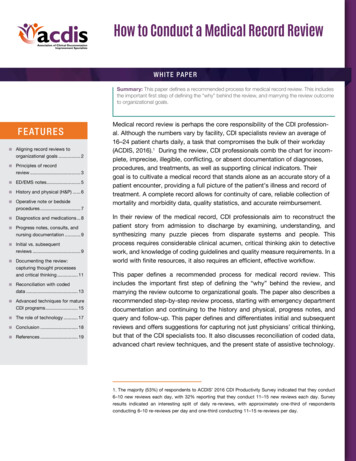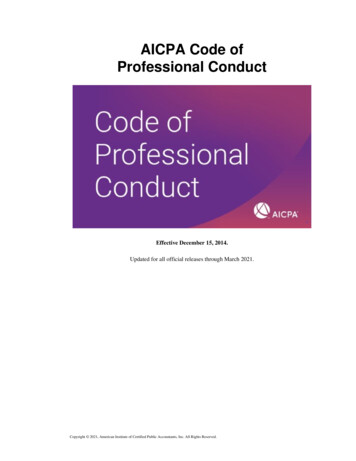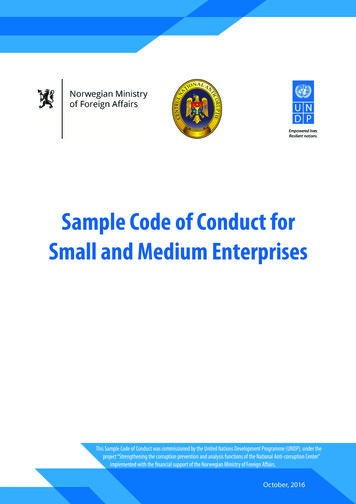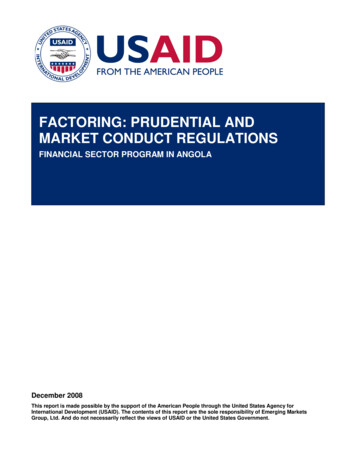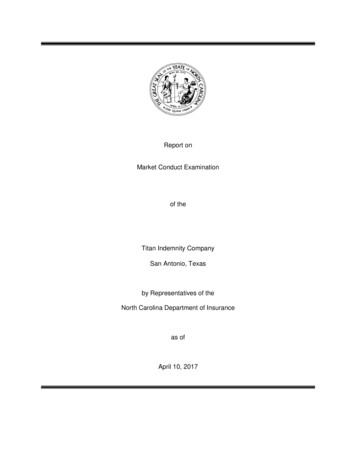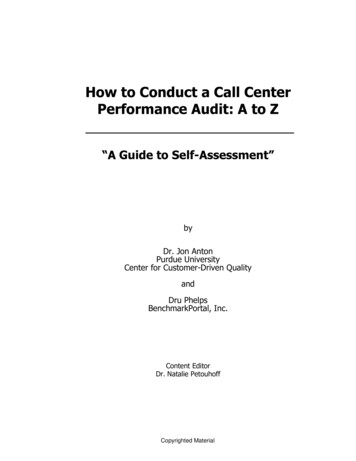
Transcription
How to Conduct a Call CenterPerformance Audit: A to Z“A Guide to Self-Assessment”byDr. Jon AntonPurdue UniversityCenter for Customer-Driven QualityandDru PhelpsBenchmarkPortal, Inc.Content EditorDr. Natalie PetouhoffCopyrighted Material
Business NavigationOnly two centuries ago, early explorers (adventurous business executives of thosebygone days) were guided primarily with a compass and celestial navigation usingreference points like the North Star. Today’s busy executive also needs guidancesystems with just-in-time business intelligence to navigate through the challenges oflocating, recruiting, keeping, and growing profitable customers. The Anton Pressprovides this navigational system through practical, how-to-do-it books for themodern day business executive.4th Edition, Copyright 2004 (08-Jul-04)The Anton Press, Santa Maria, CA 93455Used pursuant to license. All rights reservedNo part of this publication may be copied, scannedor reproduced without the written permission ofThe Anton Press, a division of BenchmarkPortal, Inc.,3130 Skyway Drive, Suite 702, Santa Maria, CA 93455.ISBN 0-9630464-6-2Copyrighted Material
CHAPTER 2: CALL CENTER ISSUES VS. OPPORTUNITIESBackgroundFew departments within companies have grown as quickly in the last fewyears—and become as expensive—as the call center function. Some studies showthat inbound calls from customers to companies have grown from a mere 11 millionin the mid 1980’s to over 15 billion calls in 2000, with an estimate of doubling to 30billion calls by 2005. Because of this wildfire growth, most companies have focusedprimarily on just “containing” the phenomenon, i.e., adding people, telephone linesand information technology, just to answer the callers’ questions and minimizeblocked and abandoned calls.As call center costs have skyrocketed, so have the requests by management tokeep the costs down, but at the same time management wants to provide moreservices to callers more efficiently. Better utilization of existing equipment andpeople are often the short-term goal of the call center manager. But efficiencies areonly half the equation and, alone, can cause more damage than good in the long run.Forces of Change and Resulting Demand for Better Call CentersCompetition is the biggest reason for the increase in demand for better callcenters that can handle calls more effectively.Competition in virtually every industry is rapidly changing. In the last twentyfive years, global competitors have captured a dominant share of basic industries,then moved to electronics, automobiles and banking (to name a few). Entrepreneurssaw unfulfilled needs and filled them, stealing customers from muscle-bound giants.The number of new business startups and outsourced service providers have soaredto provide multiple channels of contact, including Web, chat, and e-mail response.As a result, companies can no longer afford to be unresponsive to customerrequests. If one company doesn’t meet their needs, another one will. These are goodtimes for consumers. They really are “The Boss” now, and they are using theirnewfound power of choice to demand the products they want, the way they wantthem and when they want them. Listening to the customer has become key tosurvival.The resulting demand on business is customization. Customers demand a customfit. To gain an advantage, smart companies are using call centers to monitorcustomer demands and continually develop new products, services, packaging anddelivery, based on unfulfilled customer needs.3Copyrighted Material
How To Conduct a Call Center Performance Audit: A to ZChange Management: People, Process and TechnologyNew technologies accelerate both the capabilities and demands for change,including faster communications, more detailed and timely information aboutcustomers, and more precise measurements of cost and quality. However, the needto optimize the triad of people/process/technology is necessary in order to maximizethe return on investment for implementing state-of-the-art technology and process.Many times companies get caught up in buying the best technology available. Theyfind later that not only are the bells and whistles not being used, but also the basicfunctionality of the system is not being fully utilized. A comprehensive changemanagement program is required to guide change in the workplace. Moreinformation on this can be found in Appendix A: The Demand Generation Seminar,and in Appendix B: Evaluating Readiness for Change and Conducting ClientInterviews.A change management program looks at: assessing the readiness and capability of the employees to change the waythey do their work gaining management support to supply the needed training, in terms ofbudget and schedule creating a communication plan around the time line and the changes to thetechnology and workflow processes outlining the current processes that the technology supports and mapping theprocess that new technology would create creating an implementation plan and schedule to realistically transitionlegacy systems to the new system and running the old systems in parallel fora period of time to ensure seamless transition creating a lessons-learned process so that once the new system is running,improvements and updates can easily be made and employees can be trainedon the changesWhat Works NowMost industries are in a period of global over-capacity. As consumers vote withtheir dollars, many companies are thrust into survival mode. This is especially trueof those who were successful under the old rules. They carry the baggage of “whatused to work,” even though “it” no longer does. They are in the habit of focusing oninternal issues, not the customer. They hold onto both a culture and processes basedon outdated models. In order to prosper, they must re-engineer and change the waythey do business, not only to be cost efficient, but market-driven and effective.Thus, nimble companies are growing rapidly as a result of listening to customersand serving their needs, often one customer or segment at a time. They grow byallowing employees (a) the freedom to stay close to the customer, and (b) the abilityto quickly react to customer needs (empowerment). A pattern of success is emerging.4Copyrighted Material
Chapter 2: Call Center Issues vs. OpportunitiesAlso, fast-growing companies are often unburdened by the past. They are eithernewer, start-up customer-care centers—or they have in some way (a result ofacquisition, for example) taken a fresh approach to knowledge management throughcall center information automation. Another growing area is that of the outsourceservice provider, who manage the entire customer service transaction from a remotelocation, at times from offshore sites. In all cases, the need for a call centerassessment remains crucial in the time of change.Re-engineering the Call CenterThe model for reengineering for optimization has most recently been directedtoward one of two objectives. Two of the latest keys to success are enhancingcustomer focus or the use of information technology.Until recently, however, “know thy customer” was usually easier said than done.Computer technology just wasn’t up to the job: the data existed but were toovoluminous, too widely scattered throughout the organization, and too inconsistentlyrecorded for effective use. But now with powerful workstations, client serverplatforms, extensive networks, specialized software packages and extra-powerfuldatabase engines, technology is no longer the problem.The single most important thing a company can do is to understand the needs ofcurrent and prospective customers by proper use of information readily availablethrough their call centers. The laggards will have to do it to survive. The leaders willdo it to become even more successful.A well-implemented call center helps: retain current customers and attract new ones define and track what they value define and meet customer-perceived quality standards listen, then customize products and services anticipate the next hot product as articulated by the callers meet customer expectations by providing quick, accurate answers whenneeded by the customer maximize profits in the processThis sounds easy and, indeed, most companies will insist they are customerfocused, but those closest to the customer are the most successful. The good news forconsultants is that few companies adequately utilize all existing informationtechnology in their call centers, leaving a great deal of room for improvement.The objective for improving the call center is often survival and/or growth. In anycase, being internally focused will no longer work. Due to cost pressures, more and5Copyrighted Material
How To Conduct a Call Center Performance Audit: A to Zmore customer contacts will come through call centers and other electroniccommunications.Information technology plays a very important role in addressing the call centerbusiness process. For example: The moderate cost and multi-function of information technology. Telecommunication technology now makes it possible to track customerpreferences one at a time. Web and Internet services expand to reconfigure traditional customerinformation channels. The ability to integrate telephone and computer technology (includingmultimedia) provides new ways to support knowledge managementaccessibility in order to provide a prompt and accurate reply.Opportunity ExistsThe ever-improving world of information/telecommunication technologyaccelerates change. Change creates opportunity. The new rules for business successallow nimble, customer-focused organizations to steal customers from existinggiants. This creates opportunity for those who can assist companies to improve theircall center through expert auditing and consulting and the efficient use oftechnology.The site assessment is an entry vehicle to a client’s call center environment. It isdesigned to document a call center’s current use of information technology andpeople, and pinpoint opportunities for improvement and/or re-engineering. Becausemany call center functions grew in an unplanned manner, they are often strugglingsimply to answer calls. They have neither formal process for improving their plight,nor the vision for turning their call center into a “high-tech and high-touch”competitive advantage.The site assessment may uncover the need for the following: expansion and upgrade of existing equipmentimprovement in standards, procedures, and policiesquantifying and tracking customer service levelsbusiness process mapping for efficient workflowattracting, selecting and training quality staffmanagement and people skills traininga corporate culture change6Copyrighted Material
Chapter 2: Call Center Issues vs. OpportunitiesOnce the business issues are addressed, there are significant opportunities forimplementing and supporting information technology, including: client/server computing applications from a customer point of view, asopposed to existing internal (i.e., product) perspectives computer telephone integration relational database implementation electronic distribution channels multimedia and the Web-based catalog imaging of product data and pictures call-pathing of inbound numbersCapitalizing on the OpportunityIt’s easy to fall victim to old ways of thinking about customer contact; businessesdo it and so do vendors. In these exciting times for technologies (with rapidadvancements, increasing ease of use, and ever-improving price performance), thosewho have lived with technology should avoid the temptation to lead with technology.It may be trendy and alluring to discuss the latest chip, workstation, server ordigital technology, but it is not the optimal decision factor to select a significantbusiness initiative or solution.To determine the value of growth or the cost of poor performance, conduct a fullbenchmark audit to measure and prioritize critical opportunities. Select a sound,tested survey to measure performance in operations, technology, human resources,cost, facilities, knowledge management, and customer service. Examine not only howto improve internal processes, but also run a peer-group comparison with at least 2030 competitors in your market. Purdue University research from the Center forCustomer-Driven Quality developed a benchmark methodology some years ago.Currently, the survey and core findings from this datamart of best practices arefound at www.BenchmarkPortal.com . The custom peer-group reports that you willobtain for your center are essential management tools that prioritize optimal areasfor change. See Appendix Z for the blueprint on Benchmarking.7Copyrighted Material
CHAPTER 9: COST/BENEFIT ANALYSIS,OR RETURN ON INVESTMENT (ROI)FOR CALL CENTER ENHANCEMENTSWhy Should You Perform a Cost/Benefit Analysis?Call center improvement initiatives should provide measurable benefits forcustomers, stakeholders, and shareholders alike. This is proven through improvedfinancial results. Discussion of relative financial measures do not come easy to manycall center managers. However, learning the language and performing the analysisused by your CFO will help you to gain respect, access, and resources over time.Defining ROIEvery chief executive officer has a fiduciary duty to maximize the return onevery dollar of capital available to the company. Therefore, with a limited supply ofcapital for investments in process enhancements, every proposal for capitalexpenditure must be accompanied by a complete financial analysis demonstratingthe expected return to the company of the proposed investment.There are classically two ways to approach an ROI endeavor:1. Cost reduction and/or cost avoidance“Direct costs” are those expense items that can be directly attached to aproduct or service offered by the company, and that can also be easily trackedby the company’s accounting system. Indirect costs are those less tangiblecosts not as easily tracked by the accounting system and therefore oftenl
call center through expert auditing and consulting and the efficient use of technology. The site assessment is an entry vehicle to a client’s call center environment. It is designed to document a call center’s current use of information technology and people, and pinpoint opportunities for improvement and/or re-engineering. BecauseFile Size: 276KBPage Count: 10

